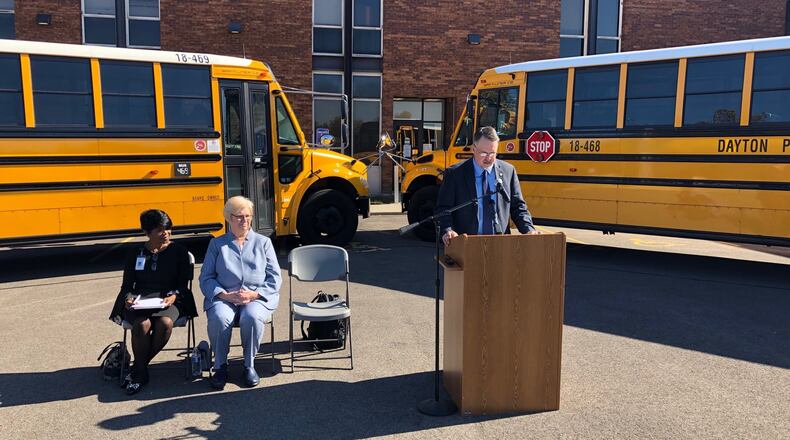RELATED: Dayton among schools affected by bus recall
“We know that diesel exhaust has a negative impact on human health, especially for children, who have a faster breathing rate than adults, and whose lungs are not yet fully developed,” Thiede said.
Dayton Public Schools has cited high asthma rates among its students for years, leading to many missed school days. DPS has been making the change to clean diesel buses on its own in recent years. The massive 2017 bus purchase (115 buses of the current 186-bus fleet) were also clean diesel buses, according to Associate Superintendent Shelia Burton.
She said the district is now trying to replace the last of its old buses 15 at a time. Burton said the district’s oldest remaining buses are 14-17 years old.
The grant money is a mix of $55,000 in federal funds from the Diesel Emission Reduction Act (DERA) and $275,000 in state EPA funds from the Volkswagen emissions scandal settlement, according to Thiede. The remaining $991,000 for the 15 buses will be paid by Dayton Public Schools.
RELATED: Dayton changes high school busing procedure
Carolyn Watkins, the Ohio EPA’s chief of the office of environment education, said about $6 million has already been invested statewide to help replace 320 old school buses. She said over the next week another $5 million will be awarded to help replace another 132 with clean diesel buses. Thiede said DERA funding has helped schools buy almost 25,000 cleaner buses nationwide.
Watkins said the new lower-emissions buses are crucial because fine soot particles in bus exhaust “do the most damage in the lungs” as they can lodge deeply.
“It’s huge in terms of both the kids standing next to those buses in line and the drivers who are working with those buses all day,” Watkins said.
Watkins said Dayton Public Schools and other districts have anti-idling policies that require the driver to turn off the bus engine after a certain number of minutes of idling, to reduce exposure. Watkins said bus drivers are following those rules well, but many parents in school pick-up lines are not.
RELATED: Ohio may toughen penalties on school bus laws
Burton said DPS tries to limit student exposure to bus exhaust by waiting to bring students out to the pickup spot until their bus pulls up to the building.
Terrance and Torronce Jackson, twin brothers who drive buses for DPS, said the new buses’ advantages go beyond better emissions. Torronce said they have fewer breakdowns and morning start-up problems, leading to better on-time performance. Terrance said they also have a much smoother ride, not bouncing the kids as much on bumpy roads.
Thiede said the grant announcement in October is a great way to celebrate Children’s Health Month.
“I expect that Dayton schoolchildren will continue to make memories aboard these yellow buses, as we all have,” he said. “We can now hope that choking on diesel fumes will not be one of those memories.”
About the Author

